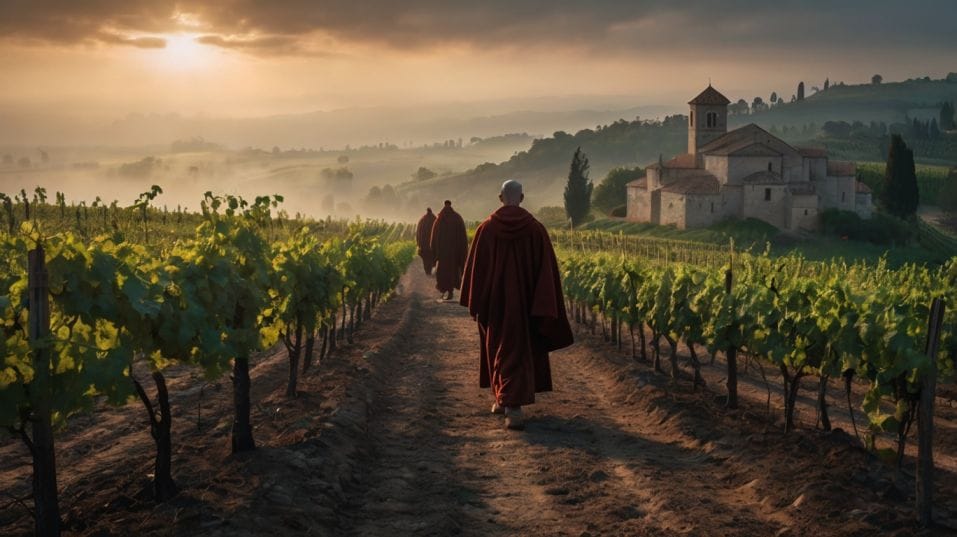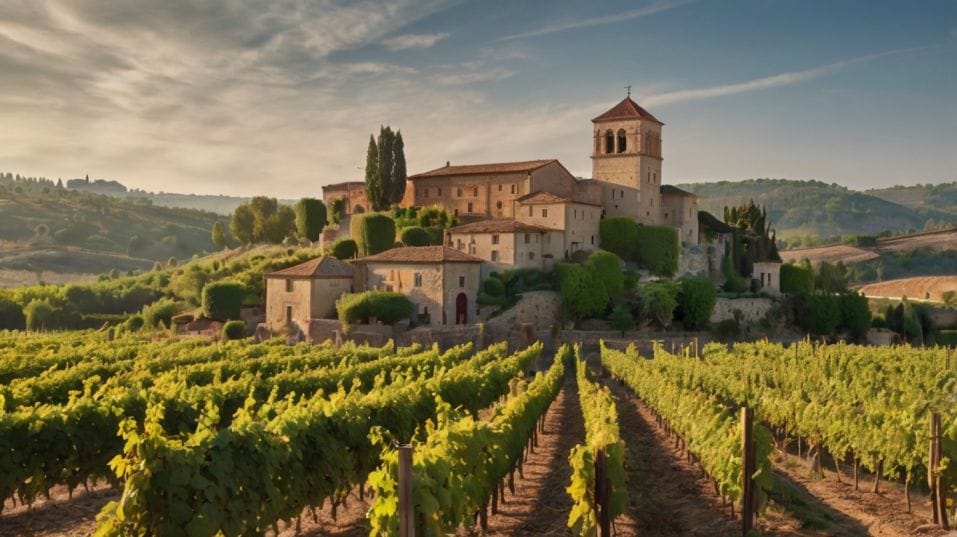Why Monks Perfected French Wine
Discover how French monks shaped modern wine. Learn to taste with clarity, balance, and purpose—just as they did, centuries ago.

What if the best way to understand wine isn’t through tasting notes or trendy guides—but by following monks? Long before wine became a luxury, French monastic orders quietly shaped how we grow, make, and taste it today.
They didn’t chase status. They chased meaning. By studying the land and refining their craft over centuries, they created the foundation for great wine. And if you’re early in your wine journey, their mindset might just transform yours.
The Vineyard Was Sacred Ground
Monks were among the first to treat vineyards not as land to be worked, but as sites to be studied.
Starting as early as the 6th century, Benedictine and later Cistercian monks in regions like Burgundy, Champagne, and the Loire Valley began keeping meticulous records.
They tracked rainfall, soil type, slope angle, sun exposure—then tasted the results. Again and again.
What emerged was an early map of terroir—a French term that’s central to wine but often misunderstood. Terroir doesn’t just mean “soil.”
It refers to the complete environment that shapes a wine: climate, aspect, altitude, geology, and even tradition. Monks were the first to take this idea seriously.
They didn’t blend grapes from different sites to create consistency. They separated them, even within the same abbey walls, to preserve nuance.
Their goal wasn’t to make the same wine every year. It was to understand what made each parcel unique.
Tasting With Place in Mind
That same curiosity can shape how you taste. Instead of asking if a wine is “good,” ask where it comes from—and how that place shows up in the glass. A Chardonnay from Chablis will feel different than one from Meursault.
One leans mineral and sharp, the other round and creamy. Neither is objectively better. But one may speak to your preferences more clearly. That’s how a smarter wine habit begins: not with favorites, but with comparisons.

Technique Was Rooted in Restraint
Winemaking in medieval France wasn’t advanced, at least not by today’s standards. There were no temperature-controlled cellars or stainless steel tanks.
Monks relied on natural yeast, hand-harvested grapes, and fermentation methods passed down through observation. Yet what they lacked in tools, they made up for in discipline.
They understood the importance of timing—when to prune, when to pick, how long to press or ferment. Every step had a rhythm, learned through decades of repetition and reflection.
More importantly, they valued balance. They didn’t chase ripeness or alcohol. They weren’t trying to impress guests or market a product. Their goal was harmony—wine that felt alive but centered, expressive but controlled.
That kind of restraint is still the hallmark of great bottles today. Wines with structure. Wines that evolve in the glass. Wines that don’t need to shout.
Tasting for Balance, Not Impact
You can develop that same instinct as a taster. Look for wines that feel complete but not overloaded. Pay attention to finish—not just the first sip, but what lingers.
Balance isn’t about being bland; it’s about the interplay of acid, fruit, tannin, and texture. When none overpower the others, your palate relaxes. You taste more deeply. You start to understand why technique matters.
Patience Was Their Process
The monastic lifestyle was built around routine: sunrise prayers, communal meals, manual labor, silence. That structure gave monks something modern winemakers often lack—time. They weren’t chasing sales.
They were watching how vines responded to wet years versus dry, to early frosts and long summers. They understood vintage variation before the term existed.
And because they planted vines for generations to come, they thought long-term. Every decision was made with continuity in mind.
This patient approach didn’t just improve the wine. It shaped the culture of tasting itself. The monks taught that wine wasn't meant to be rushed or judged at a glance.
It was meant to be contemplated. They tasted with humility and memory—two traits that still matter more than any tasting note or rating system.
Training Yourself to Taste Slowly
Today, developing that same mindset is a quiet advantage. The more time you spend with a single bottle, the more you start to notice its arc. The way it opens up.
The way it shifts with food or air. The way your own preferences evolve over time. You stop drinking wine to validate your choices—and start tasting it to expand them.
Legacy That Lasts
The work of French monks wasn’t confined to Burgundy. In Champagne, they refined techniques for secondary fermentation, which eventually led to sparkling wine.
In the Rhône, they mapped hillsides where Syrah thrived. In Alsace, they maintained viticultural practices through centuries of political upheaval.
Their fingerprints are everywhere—not just in the physical vineyards they left behind, but in the values they embedded into the culture of wine: care, observation, and a relentless pursuit of clarity.
Recognizing the Monastic Blueprint in Your Glass
You benefit from that legacy every time you pour a wine that feels precise. Every time you notice a subtle difference between vintages.
Every time you fall for a bottle not because someone told you to, but because it genuinely speaks to your palate. That’s the difference between drinking wine and understanding it.
Final Thoughts
Monks didn’t perfect French wine through magic. They did it by showing up—year after year, vintage after vintage—with curiosity and care.
They trusted their senses, recorded their results, and always returned to the vineyard with better questions. In doing so, they left behind something far greater than tradition: a blueprint for how to taste with purpose.
So bring that mindset into your next glass. Choose a wine from a region with depth—Burgundy, the Loire, the Rhône—and take your time with it.
Taste like the monks did: slowly, attentively, without distraction. Let the flavors unfold, and let your own understanding evolve. Add something new to your ritual today—not just a bottle, but a mindset. Wine gets better when you do.




